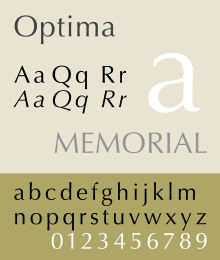Optima
 |
|
| Category | Sans-serif |
|---|---|
| Classification | Humanist |
| Designer(s) | Hermann Zapf |
| Foundry | Stempel Linotype |
| Date released | 1955 |
| Variations | Optima Nova |
Optima is a humanist sans-serif typeface designed by Hermann Zapf and released between 1952 and 1955 for the D. Stempel AG foundry, Frankfurt, Germany.
Though classified as a sans-serif, Optima has a subtle swelling at the terminals suggesting a glyphic serif. Optima was inspired by Roman and Italian stonecarving.
Zapf intended Optima to be a typeface that could serve for both body text and titling. To prove its versatility, Zapf set his entire book About Alphabets in the regular weight. Zapf retained an interest in the design, collaborating on variants and expansions into his eighties.
Optima’s design follows humanist lines; its capitals (like those of Palatino, Hans Eduard Meier’s Syntax and Carol Twombly's Trajan) are directly derived from the classic Roman monumental capital model, reflecting a reverence for Roman capitals as an ideal form.
Optima is an example of a modulated-stroke sans-serif, a design type where the strokes are variable in width. The design style has been intermittently popular since the late nineteenth century; Optima is one of the most lastingly popular examples of the genre. Optima was originally targeted by Stempel's Walter Cunz as a competitor to Ludwig & Mayer's Colonia design, which has not been digitised. Shaw also suggests the little-known 1948 design Romann Antiqua, as well as Stellar by Robert Hunter Middleton as predecessors, and notes the existence of Pascal by José Mendoza y Almeida (1962) as a design with a similar set of influences. Optima is however quite restrained in stroke width variation; more display-oriented predecessors such as Britannic show far more differentiation in stroke width than Optima does.
Zapf began his design while visiting Italy in 1950 and examining inscriptions there, especially at the cemetery of the Basilica di Santa Croce in Florence; an early draft of the design was quickly sketched on a 1000 lira banknote.
...
Wikipedia
